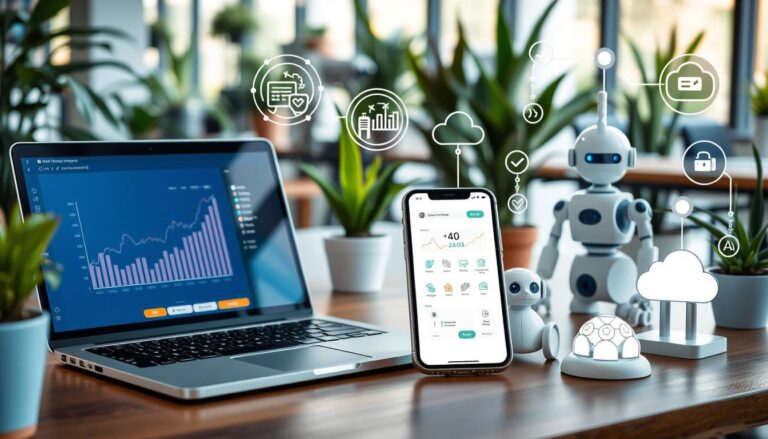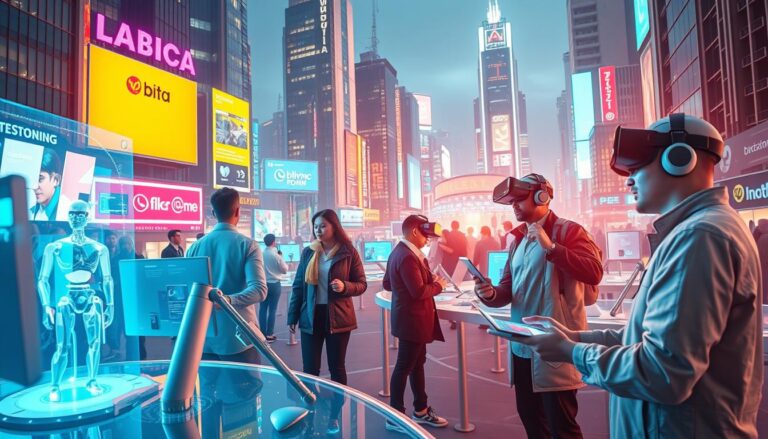Ever wondered how machines can write text that feels almost like a human? GPT models are leading the way in this amazing field. They use advanced AI to improve many areas, like natural language processing (NLP). OpenAI has developed these models, starting with GPT-1 and now reaching GPT-4, which can handle different types of data.
These systems have been trained on huge amounts of data. They can create responses that make sense and fit the context. This is useful in many fields, like customer service, creating content, and even in healthcare12. Knowing how they work is important for anyone who wants to use AI in their work.
Key Takeaways
- GPT models are advanced AI systems that excel in human-like text generation.
- They have evolved significantly from GPT-1 to GPT-4, with millions of parameters supporting complex functionalities.
- The potential applications of GPT include customer service, healthcare, education, and more.
- Understanding GPT technology enhances its utility for users across various sectors.
- The future of AI and conversational AI rests heavily on the advancements made in GPT models.
Overview of GPT Models
The definition of GPT is Generative Pre-trained Transformers. These are advanced AI models made by OpenAI to create text that sounds like it was written by a human. Since GPT-1 came out in 2018, there has been a big leap in how these models work. They use deep learning to do many language tasks, helping in many areas.
Definition and Evolution of GPT
GPT-1 was a big deal when it first came out. It used a huge dataset of books and had 117 million parameters. It was better than many other models at 9 out of 12 tasks3.
Then, GPT-2 was made, with even more parameters, 1.5 billion, and a bigger dataset. It had a 48-layer model and a huge vocabulary. This made it understand context better3.
The Transition from GPT-1 to GPT-4
With time, GPT-3 was introduced, with 175 billion parameters. It made text that was more coherent and relevant. GPT-4 came out in 2023, with 1.8 trillion parameters, a huge jump from GPT-34.
In May 2024, GPT-4o was announced. It can handle text, audio, and visual data at the same time. It even showed off real-time translation during a live demo4.
How GPT Models Function
GPT models work thanks to their advanced architecture. This architecture is based on the transformer model, which changed how we process language. It uses self-attention to understand and create text.
This method lets the model look at different parts of the text at the same time. This helps it find connections and meanings in the text.
Architecture of GPT Models
The GPT model has two main parts: an encoder and a decoder. The encoder turns the input text into a special kind of data called embeddings. These embeddings are like a summary of the text.
The decoder then uses these embeddings to create text that makes sense and fits the context. This setup makes the model very good at handling complex language tasks.
Role of Transformers in Language Processing
Transformers are key to making GPT models better at understanding language. They use attention to focus on important words. This helps the model understand the context better.
This approach makes the text generated by the model sound more natural. It also opens up new possibilities for AI, like writing code and understanding language better56.

Key Features of AI Language Models
AI language models, like GPT-4, are changing how we talk and write. They can make text that looks like it was written by a person. This is great for chatbots and virtual assistants, making our interactions better.
Text Generation Capabilities
These models can create top-notch text. ChatGPT uses big datasets to learn and mimic different writing styles. This is key for tasks like making content and answering questions automatically.
Studies show AI is making industries better by helping with tasks like customer support. It can understand and answer user questions in a way that feels natural7.
They can also make reports and articles, saving businesses time. This means they can keep their text quality high7. Plus, they help with analyzing data, giving us new insights from text8.
Understanding Context and Semantics
AI models are good at understanding the context of what’s being said. They get not just the words, but the meaning behind them. This makes their answers more relevant and useful8.
They use deep learning to spot patterns and feelings in lots of data. This makes them better at understanding what’s being said. Thanks to tech advances, these models are getting more accurate at processing language7.
Applications of GPT Models
GPT models are used in many areas. They help in content creation, customer service, and education. These tools make creating content easier, answer customer questions fast, and make learning more personal. Knowing how they work in different fields is key.
Use in Content Creation
GPT models help writers and marketers make better content. They can write articles, help with creative tasks, and solve writer’s block. The global NLP market, which includes content generation, was worth $11.1 billion in 2020. It’s expected to grow to $341.5 billion by 2030, showing how much tech is used in creative work9.
Role in Customer Service Solutions
GPT models change how companies talk to customers. AI chatbots, powered by these models, quickly solve problems. This makes customers happier and saves money for businesses. GPT models understand what’s being said, making them good at answering questions9.
This makes service better and helps businesses make smart choices. It shows how AI in customer service is changing the game.
Adoption in Education and Learning
In schools, GPT models make learning more personal. They help students with their own learning style and needs. These models help with tutoring, answering questions, and finding extra resources.
With a growth rate of 40.9% for the NLP market, schools are seeing the benefits. This means a future where learning is more tailored and effective for everyone910.

Benefits of Using GPT Models
GPT models have changed many fields by making things more efficient and improving how users experience them. They help with boring writing tasks, so you can focus on big ideas and creativity. They can quickly make text that fits perfectly, speeding up work in marketing and customer service.
Enhancing Productivity and Efficiency
The benefits of GPT models go beyond what old tools can do. They help companies work smarter by automating tasks, saving a lot of time. For example, making custom content or answering customer questions fast and right, boosting productivity a lot. This makes it easier to keep up with the quick pace of today’s world116.
Improving User Experience in Digital Platforms
GPT models also make online interactions better and more fun. They quickly and accurately answer user questions. In customer service, they lead to happier users who get the help they need fast. This makes them key in keeping customers happy across different platforms116.

| Feature | Benefits |
|---|---|
| Productivity Enhancement | Automation of tasks, time savings, allows focus on strategic initiatives |
| User Experience Improvement | Engaging interactions, prompt responses, higher user satisfaction |
| Industry Applications | Content creation, customer service, data analysis |
| Model Versatility | Different versions cater to specific functions, enhancing task effectiveness |
Ethics and Considerations in AI
Artificial intelligence is growing fast, and talking about ethics in AI is getting more urgent. We need to tackle bias in language models, make AI clear, and hold people accountable for AI actions. If we don’t, it could harm many people and communities.
Addressing Bias in AI Language Models
Bias in AI language models comes from biased data and how the algorithms are made. This can unfairly treat some groups. Studies show that bias in NLP comes from data and algorithms, so we need fair systems12.
Companies should use diverse data and fair methods to fix bias. This way, AI can work better and help achieve social justice.
Maintaining Transparency and Accountability
Being open about how AI works is key to trust. When users know how models are made and what data they use, they can use AI ethically. This openness helps users understand AI’s decisions12.
AI companies must take responsibility for their tech’s effects. They should manage risks and encourage good use. By doing this, they help make AI development more ethical.
Training and Fine-Tuning of GPT Models
The training and fine-tuning of GPT models are key steps that greatly affect their performance. These models learn from huge training datasets from the internet. This learning helps them understand language better, making them useful in many tasks.
Datasets Used for Training
Big datasets are vital for starting model training. They help models like GPT-3 become great at tasks like language translation and text summarization13. These datasets are full of written content, teaching the model about language.
Techniques for Fine-Tuning Models
Fine-tuning is crucial for making models better match what users need. Techniques like reinforcement learning help models get better over time. This is important because models trained on big datasets may not do well in all tasks13.Fine-tuning pre-trained models like GPT makes them better at tasks like dialogue and summarization14.

Future Trends in AI and Language Processing
Artificial intelligence is growing fast, and you might be curious about its future. The advancements in GPT technology are changing how we understand and create language. This could lead to more advanced uses in the future.
Potential Developments in GPT Technology
GPT technology is getting better with new algorithms. By 2025, the NLP market could hit $43.3 billion, showing a big need for new ideas15. Models like BERT and GPT are already making a big impact in NLP tasks, showing their power in understanding and creating text1615.
Integration with Other AI Technologies
GPT models are also being mixed with other AI tech. For example, adding GPT to image and voice recognition makes AI more interactive. This is seen in chatbots and virtual assistants, which use NLP for better user service. These tools help with customer service and learn from user feedback, showing AI’s wide use16.

| Trend | Description | Projected Impact |
|---|---|---|
| Advanced Algorithms | Development of improved language models that enhance understanding. | More accurate and coherent text generation. |
| AI Integration | Combining GPT with visual and audio processing technologies. | Creation of more intuitive and user-friendly applications. |
| NLP Market Growth | Expected growth of the NLP market to $43.3 billion by 2025. | Increased investment in AI technologies across industries. |
Learn more about the significance of developments in GPT technology and future trends in AI
It’s clear that the upcoming advancements will significantly influence how users interact with technology, making processes more accessible and efficient.
The trends point to a bright future for AI in our lives. They promise to change how we use AI in many areas1615.
Challenges Facing GPT Models
The world of GPT models is full of new ideas but also faces big challenges. These models are getting smarter, but they need a lot of computing power and can spread false information. It’s important to understand these problems to make AI better.
Computational Resources and Accessibility
Creating top models like OpenAI’s GPT-3 shows how much computing power is needed. GPT-3 does well on tests like GLUE and SuperGLUE, showing it’s good at understanding and reasoning17. But, this means only big groups or researchers can use these tools. As models get even bigger, like Google’s PaLM, the need for more computing power grows, making it harder for everyone to access them17.
Issues with Misinformation and Misuse
GPT models can write like humans, but this also means they can spread false information. A study found that 51% of NLP experts think these models can understand language17. But, there’s a debate if they really get it or just mimic what they’ve learned. This makes it important to have rules for using these models responsibly. As NLP becomes part of our daily lives, the risk of false information in important areas like health and business grows18.
Conclusion: The Importance of GPT Models in Modern AI
GPT models are a big step forward in natural language processing (NLP). They can create text that makes sense and fits the context. This makes them very useful in chatbots, creating content, and helping with customer service1920.
They learn in two steps: first, they train on huge datasets, and then they fine-tune for specific tasks. This helps them do well in tasks like understanding feelings, translating, and more1920. It’s also important to make sure they don’t have biases, so we use them responsibly in tech.
The future of AI in NLP looks bright. GPT-3 and other models will make talking to machines easier and more meaningful. They work well with other tech, making virtual assistants smarter and user experiences better2120. As they get better, they’ll help us understand and use human language in new ways.
In short, GPT models are changing many fields fast. They show how important it is to keep researching and working together. By understanding and using these advancements, we can lead in the AI world of NLP19. For more on NLP, check out this article here.
FAQ
What are GPT models?
How have GPT models evolved over time?
What is the architecture behind GPT models?
What are the primary applications of GPT models?
How do GPT models enhance productivity?
What are the ethical considerations regarding GPT models?
What techniques are used for training and fine-tuning GPT models?
What future developments can be expected for GPT technology?
What challenges do GPT models face in their implementation?
Source Links
- What is GPT AI? – Generative Pre-Trained Transformers Explained – AWS – https://aws.amazon.com/what-is/gpt/
- Exploring the Horizon: The Future of GPT and Large Language Models in NLP – https://medium.com/@mervebdurna/exploring-the-horizon-the-future-of-gpt-and-large-language-models-in-nlp-33a6923c9291
- The Journey of Open AI GPT models – https://medium.com/walmartglobaltech/the-journey-of-open-ai-gpt-models-32d95b7b7fb2
- What is GPT (generative pre-trained transformer)? | IBM – https://www.ibm.com/think/topics/gpt
- OpenAI NLP Models – Originality.AI – https://originality.ai/blog/openai-nlp-models
- What Is GPT? GPT-3, GPT-4, and More Explained – https://www.coursera.org/articles/what-is-gpt
- LibGuides: Using AI Language Models : ChatGPT – https://hallmark.libguides.com/c.php?g=1312147&p=9644939
- What Is NLP (Natural Language Processing)? | IBM – https://www.ibm.com/topics/natural-language-processing
- GPT Models: Changing the Landscape of AI Communication – https://webisoft.com/articles/gpt-model/
- Unleashing the Power of Natural Language Processing: GPT and Beyond – https://medium.com/@soukaina./unleashing-the-power-of-natural-language-processing-gpt-and-beyond-672a420cf7aa
- OpenAI GPT-3: A New Era in Natural Language Processing – https://medium.com/@sanket.ai/openai-gpt-3-a-new-era-in-natural-language-processing-31afb2747507
- Ethical Considerations in Natural Language Processing: Bias, Fairness, and Privacy – GeeksforGeeks – https://www.geeksforgeeks.org/ethical-considerations-in-natural-language-processing-bias-fairness-and-privacy/
- A Beginner’s Guide to Understanding Natural Language Processing (NLP) with GPT – https://www.maestrolabs.com/blog-detail/beginners-guide-to-understanding-natural-language-processing-with-gpt
- Transfer Learning in Natural Language Processing (NLP): A Game-Changer for AI Models – https://medium.com/@hassaanidrees7/transfer-learning-in-natural-language-processing-nlp-a-game-changer-for-ai-models-b8739274bb02
- Natural Language Processing: How It Works and Its Future – https://www.ntiva.com/blog/what-is-natural-language-processing
- Exploring the Future of AI: Natural Language Processing (NLP) Applications and Trends – https://dev.to/citrux-digital/exploring-the-future-of-ai-natural-language-processing-nlp-applications-and-trends-1ja4
- The debate over understanding in AI’s large language models – https://pmc.ncbi.nlm.nih.gov/articles/PMC10068812/
- Unlocking AI: Natural Language Processing vs. Large Models – https://www.maxiomtech.com/natural-language-processing/
- Understanding the GPT Model: Revolutionizing Natural Language – https://www.linkedin.com/pulse/understanding-gpt-model-revolutionizing-natural-language-shyam-saran-r19nc
- The Role of Large Language Models in Shaping Generative AI – https://www.datasciencecentral.com/get-ready-for-future-innovations-with-large-language-models/
- The Role of Natural Language Processing in Modern AI Systems – https://openmedscience.com/the-role-of-natural-language-processing-in-modern-ai-systems/



